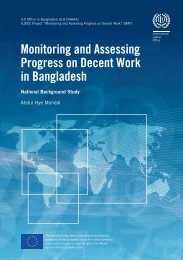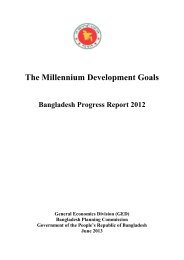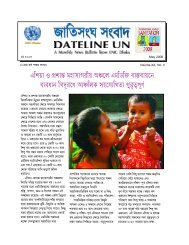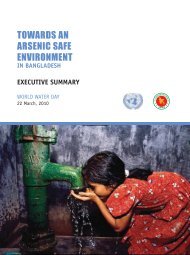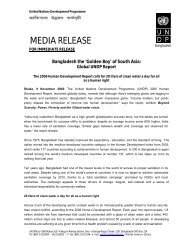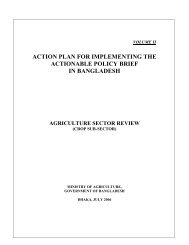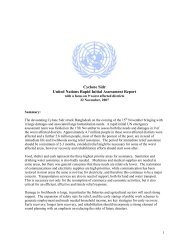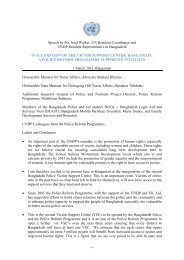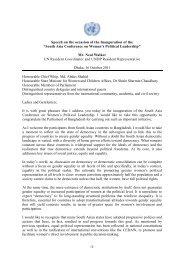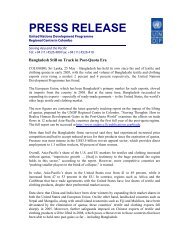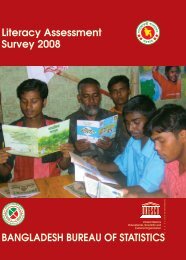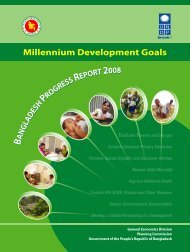Bangladesh EFA MDA National Report 2001-2005 - United Nations ...
Bangladesh EFA MDA National Report 2001-2005 - United Nations ...
Bangladesh EFA MDA National Report 2001-2005 - United Nations ...
You also want an ePaper? Increase the reach of your titles
YUMPU automatically turns print PDFs into web optimized ePapers that Google loves.
<strong>Bangladesh</strong> <strong>EFA</strong> <strong>MDA</strong> <strong>National</strong> <strong>Report</strong> <strong>2001</strong>-<strong>2005</strong>Achievements (<strong>2001</strong>-<strong>2005</strong>)The projected coverage under ECCE, both formal and non-formal, for the period <strong>2001</strong>-<strong>2005</strong> has been setat 2.02 million (formal 1 million and non-formal 1.02 million).As compared to the target the Gross Enrolment Rate has been found to be 1.1 million or 11.4% of theECCE age-group (3-5 years) population in GPS, RNGPS, KG and madrasahs (formal system), and theprivate center enrolment as percentage of total enrolment in ECCE programs has been 18.09%.The Gender Parity Index (GPI) for GER has been 1.03.This means that the ECCE targets can be achieved, provided, it is planned, programd and implemented asa thrust sector with proper inter-sectoral coordination and management, including continuous monitoringof stakeholder activities.Achieving Universal Primary Education (UPE)In order to ensure that by 2015 all children, particularly girls, children in difficult circumstances and thosebelonging to ethnic minorities have access to and compute free primary education of good quality, thegovernment of <strong>Bangladesh</strong> have set targets indicator-wise with GER at 10.3 percent, NER 83 percent,dropout rate at 25 percent, completion rate 75 percent and Quality Achievement at 30 percent.The Assessment for the period <strong>2001</strong>-<strong>2005</strong> shows that the population of the age-group 6-10 years has 17.32million. Out of this population the Gross Intake Rate (GIR) in primary education has been 108.4% with abreak-up of 105.9% for males and 111.0% for females.The Net Intake Rate (NIR) has been 94.7% (males 93.3% and females 96.1% with GPI of 1.03).The Gross Enrolment Rate has been 93.7% (males 91.2% and females 96.2% with GPI of 1.05). The NERhas been 87.2% (males 84.6% and females 90.1% with GPI of 1.07).The Repetition Rate has been 11.2% (males 11.5% and females 10.9% with GPI of 0.95). The SurvivalRate has been 52.9% (males 49% and females 56.9% with GPI of 1.16).The co-efficient of efficiency vary, institution to institution, region to region, between 75.2% in Dhaka(males 72.7% and females 77.5%) and 37.1% (males 37.7% and females 36.4%). The wastage (years inputper graduate) is considerable, between 13.5 years (males 13.3 and females 13.7 years) and 6.6 years (males6.9 and females 6.4 years).Life Skills and Lifelong LearningThe target population for life skills and lifelong learning programs are the students of the age-group 8+years for non-government institutions and 12+ years for government institutions.The Millennium Development Goals aims to increase the participation of students in Technical andVocational Education and Training institutions from the present level of 3% to a higher level of 20% by2020. The NPA-II has not set any quantitative target but aims to establish a knowledge-based andtechnologically-oriented competent society, to continue access, improve retention, quality andopportunities to pre-school children, young persons and adults.40



